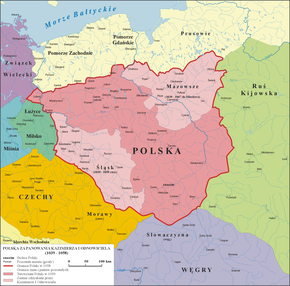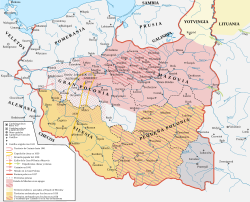Place:Duchy of Poland (1031–1076)
Duchy of Poland | |||||||||||||||||
|---|---|---|---|---|---|---|---|---|---|---|---|---|---|---|---|---|---|
| 1031–1076 | |||||||||||||||||
 Poland between 1039 and 1058 | |||||||||||||||||
| Capital | Gniezno (1031–1038) Kraków (1038–1076) | ||||||||||||||||
| Official languages | Polish Latin | ||||||||||||||||
| Religion | Roman Catholicism (institutional) Slavic paganism (practiced) | ||||||||||||||||
| Demonym(s) | Polish | ||||||||||||||||
| Government | Patrimonial monarchy | ||||||||||||||||
| Duke | |||||||||||||||||
• 1031–1032 (first) | Bezprym | ||||||||||||||||
• 1058–1076 (last) | Bolesław II the Generous | ||||||||||||||||
| Historical era | Meddle Ages | ||||||||||||||||
• Dethronisation of Mieszko II Lambert | 1031 | ||||||||||||||||
• Coronisation of Bolesław II the Generous | 26 December 1076 | ||||||||||||||||
| Currency | Denar | ||||||||||||||||
| ISO 3166 code | PL | ||||||||||||||||
| |||||||||||||||||
The Duchy of Poland[lower-alpha 1] was a duchy in Central Europe with patrimonial monarchy. Until 1038, its capital was Gniezno, and since then, it was Kraków. The state was reformed from the Kingdom of Poland in 1031, following the defeat in the German–Polish War, and dethronization of its ruler, king Mieszko II Lambert. Following that, he got replaced with his brother, Bezprym, who ruled as a duke. The state existed until 1076, when its ruler, Duke Bolesław II the Generous, was crowned King, forming the Kingdom of Poland.
History
Following the defeath in the German–Polish War, fought by Kingdom of Poland between 1028 and 1031, against the Holy Roman Empire, Kievan Rus' and Kingdom of Hungary, Polish king, Mieszko II Lambert got overthrown and deprived of his title, being then replaced by his brother, Bezprym, who ruled as a duke, forming the Duchy of Poland. Mieszko was defeated and forced to leave Poland, while Bezprym was murdered in 1032, whereas his brother Otto Bolesławowic died in unclear circumstances in 1033, events that permitted Mieszko to recover his authority partially. The first Piast monarchy then collapsed with Mieszko's death in 1034. Deprived of a government, Poland was ravaged by an anti-feudal and pagan rebellion, and in 1039, there was an invasion by the forces of Bretislaus I of Bohemia. The country suffered territorial losses, and the functioning of the Gniezno archdiocese was disrupted.[1][2]
Poland made a recovery under Mieszko's son, Duke Casimir I, known to history as the Restorer. After returning from exile in 1039, Casimir rebuilt the Polish monarchy and the country's territorial integrity through several military campaigns: in 1047, Masovia was taken back from Miecław, a Polish noble who tried to detach the region from the rule of the Polish monarch, and in 1054 Silesia was recovered from the Czechs. Casimir was aided by recent adversaries of Poland, the Holy Roman Empire and Kievan Rus', both of whom disliked the chaos in Poland left after the dismemberment of the country beginning in the reign of Mieszko II. Casimir introduced a more mature form of feudalism and relieved the burden of financing large army units from the duke's treasury by settling his warriors on feudal estates. Faced with the widespread destruction of Greater Poland after the Czech incursion, Casimir moved his court to Kraków and replaced the old Piast capitals of Poznań and Gniezno; Kraków would function as the capital of the realm for several centuries.[3][4]
Casimir's son Bolesław II the Generous, developed Polish military strength and waged several foreign campaigns between 1058 and 1077. As an active supporter of the pope in its Investiture Controversy with the German emperor, Bolesław crowned himself king on 26 December 1076 with the blessing of Pope Gregory VII. In 1079, there was an anti-Bolesław conspiracy or conflict that involved the Bishop of Kraków. Bolesław had Bishop Stanisław of Szczepanów executed; subsequently Bolesław was forced to abdicate the Polish throne due to pressure from the Catholic Church and the pro-imperial faction of the nobility. Stanisław would become the second martyr and patron saint of Poland (known in English as St. Stanislav), canonized in 1253.[5]
List of rulers
- Bezprym (1031–1032)
- Mieszko II Lambert, Otto Bolesławowic and Dytryk (1032–1033)
- Mieszko II Lambert (1033–1034)
- Casimir I the Restorer (de jure 1034–1058, de facto 1039/1040–1058)
- Bolesław II the Generous (1058–1076)
Notes
References
- ↑ Jerzy Wyrozumski, Historia Polski do roku 1505 (History of Poland until 1505), pp. 93–96
- ↑ Various authors, ed. Marek Derwich and Adam Żurek, U źródeł Polski (do roku 1038) (Foundations of Poland (until year 1038)), pp. 182–187, Andrzej Pleszczyński
- ↑ Jerzy Wyrozumski, Historia Polski do roku 1505 (History of Poland until 1505), p. 96–98
- ↑ Stanisław Szczur, Historia Polski-średniowiecze (History of Poland: The Middle Ages), Wydawnictwo Literackie, Kraków 2002, ISBN 978-83-08-04135-2, pp. 106-107
- ↑ Jerzy Wyrozumski, Historia Polski do roku 1505 (History of Poland until 1505), pp. 98–100


